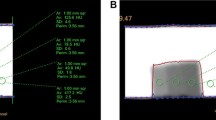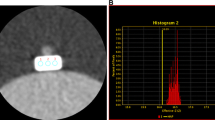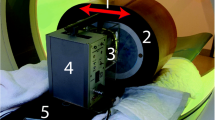Abstract
To investigate the feasibility of quantifying the chemical composition of coronary artery plaque in terms of water, lipid, protein, and calcium contents using dual-energy computed tomography (CT) in a simulation study. A CT simulation package was developed based on physical parameters of a clinical CT scanner. A digital thorax phantom was designed to simulate coronary arterial plaques in the range of 2–5 mm in diameter. Both non-calcified and calcified plaques were studied. The non-calcified plaques were simulated as a mixture of water, lipid, and protein, while the calcified plaques also contained calcium. The water, lipid, protein, and calcium compositions of the plaques were selected to be within the expected clinical range. A total of 95 plaques for each lesion size were simulated using the CT simulation package at 80 and 135 kVp. Half-value layer measurements were made to make sure the simulated dose was within the range of clinical dual energy scanning protocols. Dual-energy material decomposition using a previously developed technique was performed to determine the volumetric fraction of water, lipid, protein, and calcium contents in each plaque. For non-calcified plaque, the total volume conservation provides the third constrain for three-material decomposition with dual energy CT. For calcified plaque, a fourth criterion was introduced from a previous report suggesting a linear correlation between water and protein contents in soft tissue. For non-calcified plaque, the root mean-squared error (RMSE) of the image-based decomposition was estimated to be 0.7%, 1.5%, and 0.3% for water, lipid, and protein contents, respectively. As for the calcified plaques, the RMSE of the 5 mm plaques were estimated to be 5.6%, 5.7%, 0.2%, and 3.1%, for water, lipid, calcium, and protein contents, respectively. The RMSE increases as the plaque size reduces. The simulation results indicate that chemical composition of coronary arterial plaques can be quantified using dual-energy CT. By accurately quantifying the content of a coronary plaque lesion, our decomposition method may provide valuable insight for the assessment and stratification of coronary artery disease.







Similar content being viewed by others
References
Ren L, Rajendran K, McCollough CH, Yu L (2020) Quantitative accuracy and dose efficiency of dual-contrast imaging using dual-energy CT: a phantom study. Med Phys 47:441–456
McCollough CH, Boedeker K, Cody D et al (2020) Principles and applications of multienergy CT: report of AAPM Task Group 291. Med Phys 47:e881–e912
Gronberg F, Lundberg J, Sjolin M et al (2020) Feasibility of unconstrained three-material decomposition: imaging an excised human heart using a prototype silicon photon-counting CT detector. Eur Radiol. https://doi.org/10.1007/s00330-020-07017-y
Zhao W, Vernekohl D, Han F et al (2018) A unified material decomposition framework for quantitative dual- and triple-energy CT imaging. Med Phys 45:2964–2977
Raja AY, Moghiseh M, Bateman CJ et al (2018) Measuring identification and quantification errors in spectral CT material decomposition. Appl Sci-Basel 8:467
De Santis D, Eid M, De Cecco CN et al (2018) Dual-energy computed tomography in cardiothoracic vascular imaging. Radiol Clin N Am 56:521
Machida H, Tanaka I, Fukui R et al (2016) Dual-energy spectral CT: various clinical vascular applications. Radiographics 36:1215–1232
Alvarez RE, Macovski A (1976) Energy-selective reconstructions in X-ray computerized tomography. Phys Med Biol 21:733–744
Lehmann LA, Alvarez RE, Macovski A et al (1981) Generalized image combinations in dual KVP digital radiography. Med Phys 8:659–667
Tran DN, Straka M, Roos JE et al (2009) Dual-energy CT discrimination of iodine and calcium: experimental results and implications for lower extremity CT angiography. Acad Radiol 16:160–171
Gupta R, Phan CM, Leidecker C et al (2010) Evaluation of dual-energy CT for differentiating intracerebral hemorrhage from iodinated contrast material staining. Radiology 257:205–211
Hubbell JH, Seltzer SM (1995) Tables of x-ray mass attenuation coeeficient and mass energy absorption coefficients 1 keV to 20 MeV for elements Z=1 to 92 and 48 additional substances of dosimetric interest. NIST Report No NISTIR 5632
Liu X, Yu LF, Primak AN, McCollough CH (2009) Quantitative imaging of element composition and mass fraction using dual-energy CT: three-material decomposition. Med Phys 36:1602–1609
Johnson TRC, Krauss B, Sedlmair M et al (2007) Material differentiation by dual energy CT: initial experience. Eur Radiol 17:1510–1517
Obaid DR, Calvert PA, Gopalan D et al (2014) Dual-energy computed tomography imaging to determine atherosclerotic plaque composition: a prospective study with tissue validation. J Cardiovasc Comput 8:230–237
Mandal SR, Bharati A, Haghighi RR et al (2018) Non-invasive characterization of coronary artery atherosclerotic plaque using dual energy CT: explanation in ex-vivo samples. Physica Medica-Eur J Med Phys 45:52–58
Sangiorgi G, Rumberger JA, Severson A et al (1998) Arterial calcification and not lumen stenosis is highly correlated with atherosclerotic plaque burden in humans: a histologic study of 723 coronary artery segments using nondecalcifying methodology. J Am Coll Cardiol 31:126–133
Kuhnigk JM, Dicken V, Bornemann L et al (2006) Morphological segmentation and partial volume analysis for volumetry of solid pulmonary lesions in thoracic CT scans. IEEE Trans Med Imaging 25:417–434
Schaar JA, Muller JE, Falk E et al (2003) Terminology for high-risk and vulnerable coronary artery plaques. Report of a meeting on the vulnerable plaque, June 17 and 18, 2003, Santorini, Greece. Eur Heart J 2004(25):1077–1082
Arbab-Zadeh A, Fuster V (2015) The myth of the "vulnerable plaque": transitioning from a focus on individual lesions to atherosclerotic disease burden for coronary artery disease risk assessment. J Am Coll Cardiol 65:846–855
Johri AM, Nambi V, Naqvi TZ et al (2020) Recommendations for the assessment of carotid arterial plaque by ultrasound for the characterization of atherosclerosis and evaluation of cardiovascular risk: from the American Society of Echocardiography. J Am Soc Echocardiogr 33:917–933
Ding H, Ducote JL, Molloi S (2012) Breast composition measurement with a cadmium-zinc-telluride based spectral computed tomography system. Med Phys 39:1289–1297
Li Z, Leng S, Yu L et al (2015) Image-based material decomposition with a general volume constraint for photon-counting CT. Proc SPIE Int Soc Opt Eng 9412:94120T
Lee SW, Choi YN, Kim HJ (2014) Quantitative material decomposition using spectral computed tomography with an energy-resolved photon-counting detector. Phys Med Biol 59:5457–5482
Badea CT, Holbrook M, Clark DP, Ghaghada K (2018) Spectral imaging of iodine and gadolinium nanoparticles using dual-energy CT. Proceedings Volume 10573, Medical Imaging 2018: Physics of Medical Imaging; 105731I (2018)
Goodsitt MM, Rosenthal DI (1987) Quantitative computed-tomography scanning for measurement of bone and bone-marrow fat-content—a comparison of single-energy and dual-energy techniques using a solid synthetic phantom. Invest Radiol 22:799–810
Nowotny R, Hofer A (1985) Program for calculating diagnostic x-ray spectra. Rofo 142:685–689
van Aarle W, Palenstijn WJ, De Beenhouwer J et al (2015) The ASTRA toolbox: a platform for advanced algorithm development in electron tomography. Ultramicroscopy 157:35–47
Johnson T, Ding H, Molloi S (2013) Breast density quantification with breast computed tomography (CT): a post-mortem study. Phys Med Biol 58:8573–8591
Achenbach S, Moselewski F, Ropers D et al (2004) Detection of calcified and noncalcified coronary atherosclerotic plaque by contrast-enhanced, submillimeter multidetector spiral computed tomography—a segment-based comparison with intravascular ultrasound. Circulation 109:14–17
Hoffmann U, Moselewski F, Nieman K et al (2006) Noninvasive assessment of plaque morphology and composition in culprit and stable lesions in acute coronary syndrome and stable lesions in stable angina by multidetector computed tomography. J Am Coll Cardiol 47:1655–1662
Leber AW, Knez A, White CW et al (2003) Composition of coronary atherosclerotic plaques in patients with acute myocardial infarction and stable angina pectoris determined by contrast-enhanced multislice computed tomography. Am J Cardiol 91:714–718
Earls JP, Berman EL, Urban BA et al (2008) Prospectively gated transverse coronary CT angiography versus retrospectively gated helical technique: improved image quality and reduced radiation dose. Radiology 246:742–753
Raff GL, Gallagher MJ, O'Neill W, Goldstein JA (2005) Diagnostic accuracy of noninvasive coronary angiography using 64-slice spiral computed tomography. J Am Coll Cardiol 46:552–557
Ding H, Klopfer MJ, Ducote JL et al (2014) Breast tissue characterization with photon-counting spectral CT imaging: a postmortem breast study. Radiology 272:731–738
Vinnakota KC, Bassingthwaighte JB (2004) Myocardial density and composition: a basis for calculating intracellular metabolite concentrations. Am J Physiol-Heart C 286:H1742–H1749
Woodard HQ, White DR (1986) The composition of body-tissues. Br J Radiol 59:1209–1219
McCollough CH, Zink FE, Welch TJ (1999) Performance evaluation of a multi-slice CT system. Radiology 210:586
Kopp AF, Ohnesorge B, Becker C et al (2002) Reproducibility and accuracy of coronary calcium measurements with multi-detector row versus electron-beam CT. Radiology 225:113–119
Acknowledgements
The authors would like to thank Mr. Logan Hubbard for the useful discussion. This work was supported in part by NIH/NCI Grant No. R01CA13687.
Author information
Authors and Affiliations
Corresponding author
Ethics declarations
Conflict of interests
The authors declare that they have no conflict of interests.
Additional information
Publisher's Note
Springer Nature remains neutral with regard to jurisdictional claims in published maps and institutional affiliations.
Rights and permissions
About this article
Cite this article
Ding, H., Wang, C., Malkasian, S. et al. Characterization of arterial plaque composition with dual energy computed tomography: a simulation study. Int J Cardiovasc Imaging 37, 331–341 (2021). https://doi.org/10.1007/s10554-020-01961-y
Received:
Accepted:
Published:
Issue Date:
DOI: https://doi.org/10.1007/s10554-020-01961-y




